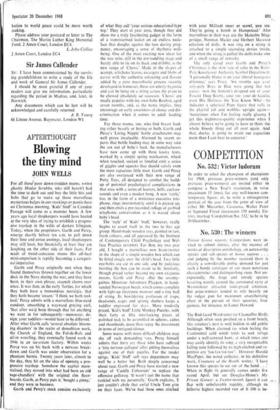No. 530: The winners
Trevor Grove reports: Competitors were in- vited to submit entries, after the manner of works of descriptive ornithology, on noteworthy species and sub-species of homo sapiens . . . and judging by the number received there is clearly a considerable public demand for just such a handy catalogue of our more notorious characteristics and distinguishing vices. Not un- expectedly, the large and unruly species hovering noisily around the communal eyrie at Westminster attracted widespread attention. But prize-winners tended to rely heavily on the vulgar pun for maximum anaesthetising effect in the pursuit of their quarries; four guineas, for instance, to Lance Haward.
The Red-faced Word-eater (or Chancellor Bird): Although often seen perched on a front bench, this creature's nest is well hidden in old public buildings. When alarmed (as when feeling the Continental cold wind) tends to seek refuge under a well-covered bank, at which times one may easily identify its song, a very recognisable falling note followed by its high-pitched and re- petitive cry lax-tax-tax-tax! However Harold, MacPiper, the noted collector, in his definitive work, Creatures of the Heath. writes: 'I have known this species to eat out of the hand . . When in flight (it generally comes under fire round April, but see Douglas-Home's My Private Grouse: a Twelve-month Sport) it can flap with unbelievable rapidity, although its hitherto highest recorded rate of 8:100 is be-
lieved to be by no means constant. Its distinc- tive plumage is an all-over drab which reaches its darkest by about the end of March. Its migration is not seasonally constant, but occurs at every wind-change. Preys on small consumer- creatures, which it plucks after squeezing to death. (Together with starlings and pigeons, the Ministry of Public Building and Works classi- fies it as a pest.) . . . and Amy Johns: We now take Terns. These appear in variety, but the Patriotic Tern, seen frequently about fifty years ago, has almost disappeared.
Appearance: Spectacular; each with their own particular spot, the 4op of the bill being a favoured position. The full breast of the female Operatic Tern is particularly noticeable especi- ally when expanded in full song.
Feeding Habits: They have a distaste for the tomatoes, orange-peel and eggs so freely given them by our grandparents and now prefer to pick their own grub. The Comic Tern lives on chestnuts, the Acrobatic (or Twistan) Tern has been seen going into low dives, while all Tern cocks must have a flow of water. Most of them settle in seedy lodgings. Terns, though often tame, become unusually shy ort hearing cat- calls, and hide their heads shamefacedly in the wings. They will respond, however, enthusiastic- ally to hearty and prolonged handclapping.
Four guineas also to-W. I. D. Scott and John Digby .The Creeping Queue-Collector: The Creeping Queue-Collector is an indigenous but partly hibernant species, which favourable weather may attract to its usual haunts at any season. A frequenter mainly of narrow trunk roads, it does not pursue its prey, but traps it in rear by skilful variations in leisurely flight.
There is a preponderance of females, mature males being rarely observed outside the mating season. Juvenile forms are distinguished by the L marking on breast and rump. Late in the life- span sex distribution tends to return to parity.
The call is imitative—loud and prolonged repetition of despairing hooting notes uttered by its prey.
Unlike its cousin, the Tail-To-Nosey-Parker, the Creeping Queue-Collector feeds on passage, thus maintaining control of prey. Detritus voided suggests fruit, sweetmeats and cigarettes as the staple diet. No specimen has so far fallen to the gun; but sportsmen remain hopeful.
Pied Trender: Of very distinctive plumage and customarily dazzling coloration. Flocks in small, albeit shrill, squadrons ahead of other species, and reacts in reverse-chameleon-habit to their appearance, assuming now the flowered, now the psychedelic, the kaftanesque and cam- panileic as the motley of Trender-distinction.
Its habitat, now largely divided between Car- naby Street and Marcland NW1, is bars (coffee and cocktail), though it disports itself very complacently in any environment where its only congenial species, the Thrusting Lensbird and the Sharpnosed Columnist, are apt busily to congregate.
A mixture of the chattering and the vehement, of the mincing and the assertive, its cry is well known to, and closely attended by, social orni- thologists. It is on 4hese, indeed—allied to inter- course with the Lensbird and the Columnist- i.that the Pied Trender's very evolution de- pends . . .



































 Previous page
Previous page